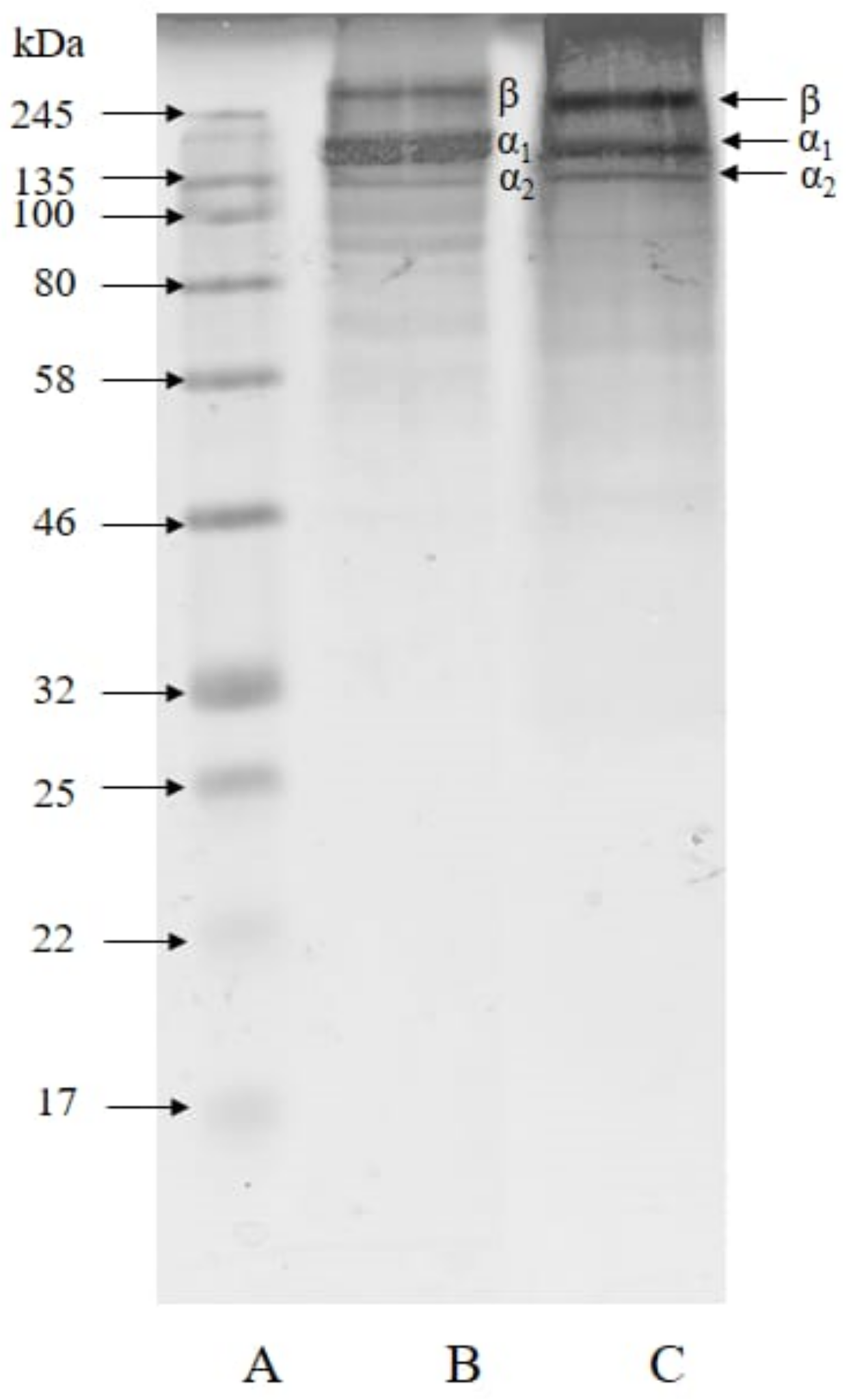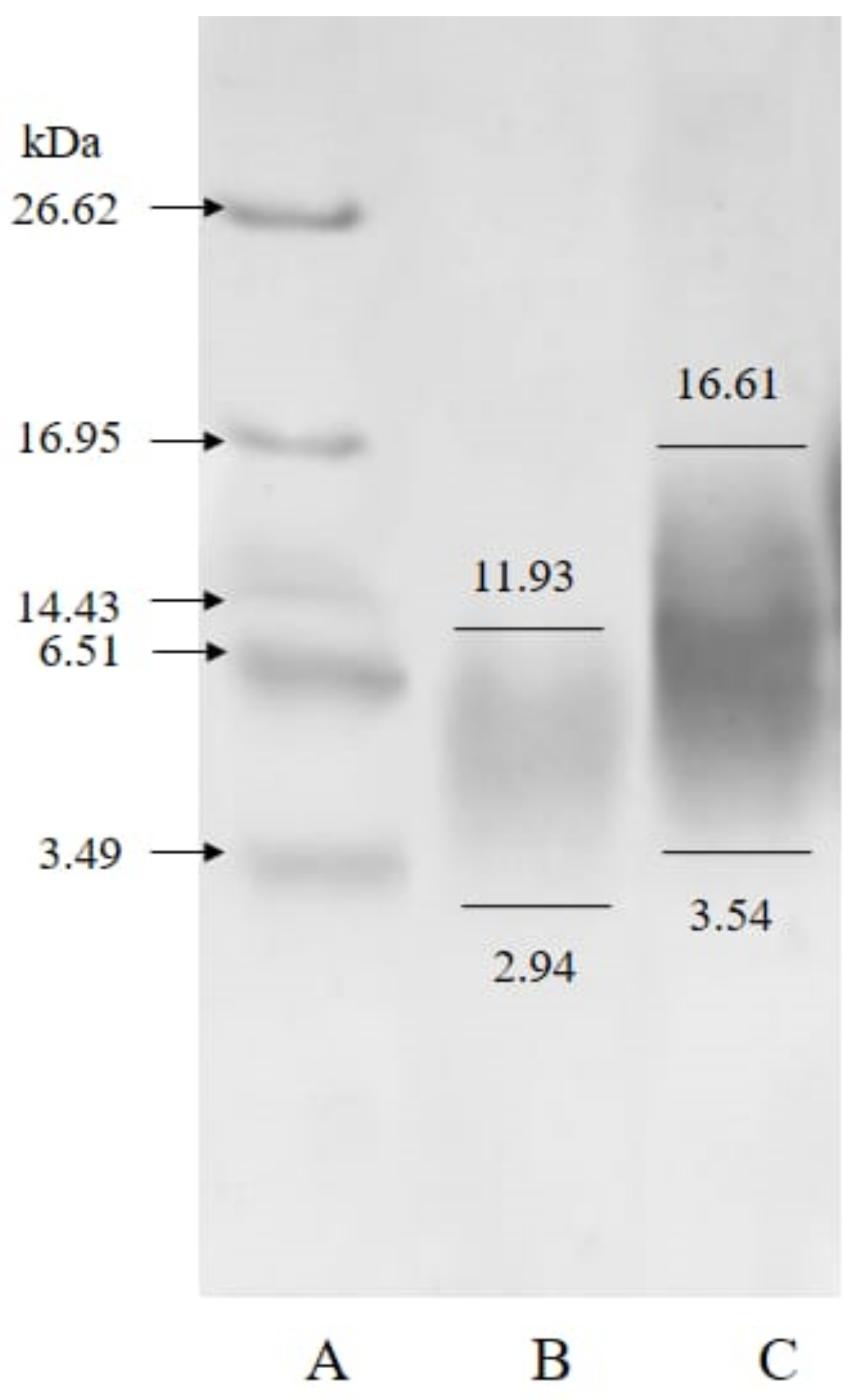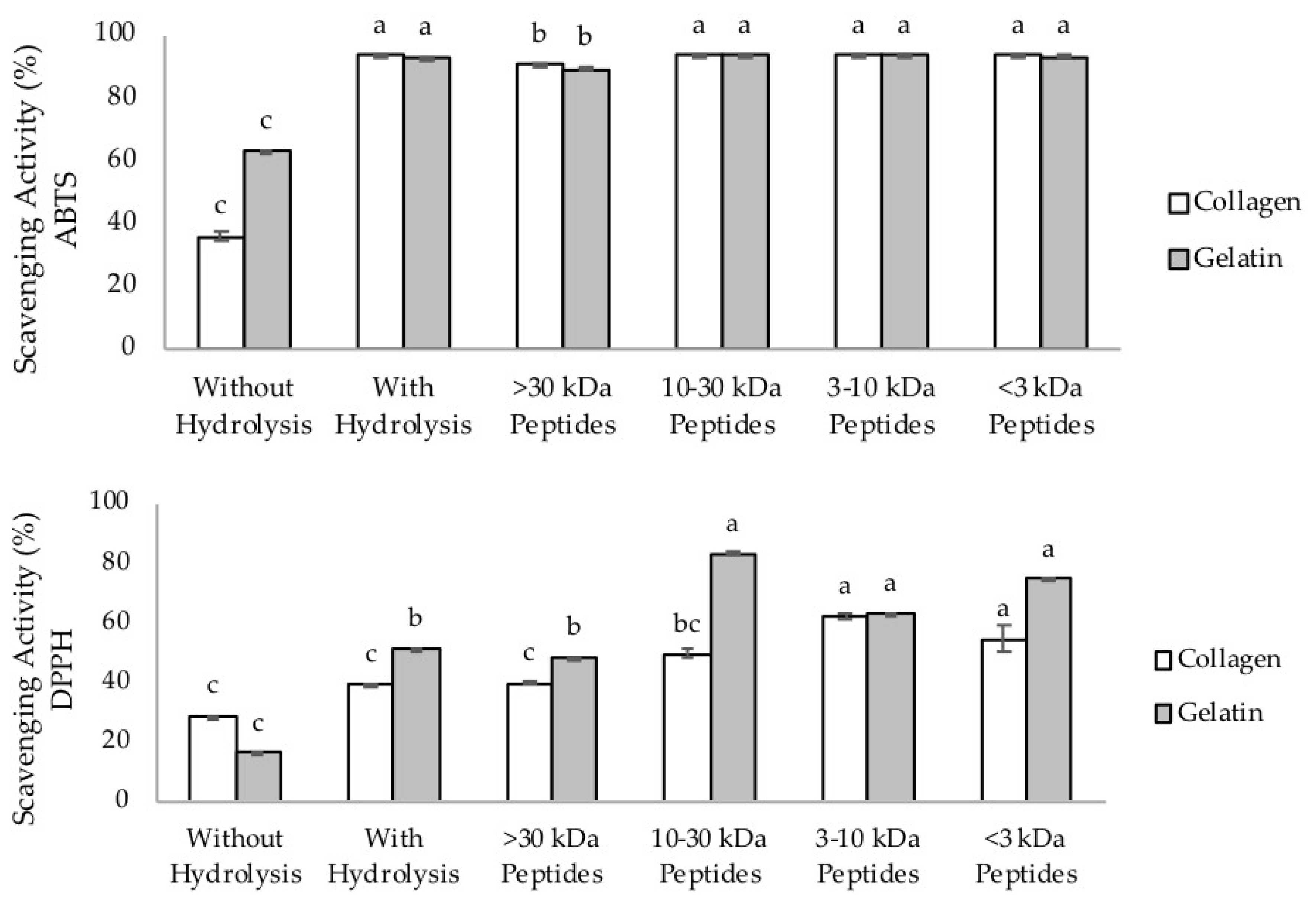Characterization and Antioxidant Activity of Collagen, Gelatin, and the Derived Peptides from Yellowfin Tuna (Thunnus albacares) Skin
Abstract
1. Introduction
2. Results and Discussion
2.1. Physicochemical Characteristics
2.2. Molecular Size and Hydrolysis Degree
2.3. Amino Acid Composition
2.4. Antioxidant Activity
3. Methods
3.1. Preparation of Collagen
3.2. Preparation of Gelatin
3.3. Preparation of Hydrolysates
3.4. Fractination
3.5. Molecular Weight Estimation
3.6. Hydrolysis Degree Analysis
3.7. Amino Acid Analysis
3.8. Antioxidant Quantification
- A0 = absorbance of ABTS/DPPH, and
- A1 = final absorbance.
- y = antioxidant activity,
- x = sample concentration,
- a = slope,
- b = intercept.
3.9. Statistical Analysis
4. Conclusions
Author Contributions
Funding
Acknowledgments
Conflicts of Interest
References
- Food and Agriculture Organization: The state of world fisheries and aquaculture. Available online: www.fao.org (accessed on 20 November 2019).
- Food and Agriculture Organization: Trends in the production of world tuna fisheries. Available online: www.fao.org (accessed on 15 November 2019).
- Food and Agriculture Organization: Information and analysis on world fish trade. Available online: www.fao.org (accessed on 26 November 2019).
- Nurilmala, M.; Ushio, H.; Kaneko, G.; Ochiai, Y. Assessment of commercial quality evaluation of yellowfin tuna Thunnus albacares meat based on myoglobin properties. Food Sci. Technol.Res. 2013, 19, 237–243. [Google Scholar] [CrossRef]
- Nurilmala, M.; Fauzi, S.; Mayasari, D.; Batubara, I. Collagen extraction from yellowfin tuna (Thunnus albacares) skin and its antioxidant activity. Jurnal Teknologi (Sci. & Eng.) 2019, 81, 141–149. [Google Scholar]
- Nurilmala, M.; Pertiwi, R.M.; Nurhayati, T.; Fauzi, S.; Batubara, I.; Ochiai, Y. Characterization of collagen and its hydrolysate from yellowfin tuna Thunnus albacares skin and their potencies as antioxidant and antiglycation agents. Fish. Sci. 2019, 85, 591–599. [Google Scholar] [CrossRef]
- Nurilmala, M.; Jacoeb, A.M.; Dzaky, R.A. Characteristics of yellowfin tuna skin gelatin. J. Pengolahan Hasil Perikanan Indonesia 2017, 20, 339–350. [Google Scholar] [CrossRef]
- Qiu, Y.T.; Wang, Y.M.; Yang, X.R.; Zhao, Y.Q.; Chi, C.F.; Wang, B. Gelatin and antioxidant peptides from gelatin hydrolysate of skipjack tuna (Katsuwonus pelamis) scales: preparation, identification and activity evaluation. Mar. Drugs 2019, 17, 565. [Google Scholar] [CrossRef]
- Aberoumand, A. Isolation and characteristics of collagen from fish waste material. World J. Fish Mar. Sci. 2010, 2, 471–474. [Google Scholar]
- Kaewdang, O.; Benjakul, S. Effect of ethanolic extract of coconut husk on gel properties of gelatin from swim bladder of yellowfin tuna. LWT-Food Sci. Technol. 2015, 62, 955–961. [Google Scholar] [CrossRef]
- Lee, C.H.; Singla, A.; Lee, Y. Biomedical applications of collagen. Int. J. Pharm. 2001, 221, 1–22. [Google Scholar] [CrossRef]
- Neves, A.C.; Harnedy, P.A.; O’Keeffe, M.B.; Alashi, M.A.; Aluko, R.E.; FitzGerald, R.J. Peptide identification in a salmon gelatin hydrolysate with antihypertensive, dipeptidyl peptidase IV inhibitory and antioxidant activities. Food Res. Int. 2017, 100, 112–120. [Google Scholar] [CrossRef]
- Alemán, A.; Giménez, B.; Montero, P.; Gómez-Guillén, M.C. Antioxidant activity of several marine skin gelatins. LWT-Food Sci. Technol. 2011, 44, 407–413. [Google Scholar] [CrossRef]
- Giménez, B.; Alemán, A.; Montero, P.; Gómez-Gullén, M.C. Antioxidant functional properties of gelatin hydrolysates obtained from skin of sole and squid. Food Chem. 2009, 114, 976–983. [Google Scholar] [CrossRef]
- Park, C.; Cha, H.-J.; Hong, S.H.; Kim, G.-Y.; Kim, S.; Kim, H.-S.; Kim, B.W.; Jeon, Y.-J.; Choi, Y.H. Protective effect of phloroglucinol on oxidative stress-induced DNA damage and apoptosis through activation of the Nrf2/HO-1 signaling pathway in HaCaT human keratinocytes. Mar. Drugs 2019, 17, 225. [Google Scholar] [CrossRef] [PubMed]
- Sonani, R.R.; Rastogi, R.P.; Madamwar, D. Antioxidant potential of phycobiliproteins: role in anti-aging research. Biochem. Anal. Biochem. 2015, 4. [Google Scholar] [CrossRef]
- Tamilmozhi, S.; Veeruraj, A.; Arumugam, M. Isolation and characterization of acid and pepsin-solubilized collagen from the skin of sailfish (Istiophorus platypterus). Food Res. Int. 2013, 54, 1499–1505. [Google Scholar] [CrossRef]
- Nagai, T.; Araki, Y.; Suzuki, N. Collagen of the skin ocellate puffer fish (Takifugu rubripes). Food Chem. 2002, 78, 173–177. [Google Scholar] [CrossRef]
- Liu, D.; Liang, L.; Regenstein, J.M.; Zhou, P. Extraction and characterization of pepsin solubilised collagen from fins, scales, skin, bones and swim bladders of bighead carp (Hypophthalmichthys nobilis). Food Chem. 2012, 133, 1441–1448. [Google Scholar] [CrossRef]
- Astiana, I.; Nurjanah, N.; Nurhayati, T. Characterization of acid soluble collagen from redbelly yellowtail fusilier fish skin (Caesio cuning). J. Pengolahan Hasil Perikanan Indonesia 2016, 19, 79–93. [Google Scholar] [CrossRef]
- Huang, Y.R.; Shiau, C.Y.; Chen, H.H.; Huang, B.C. Isolation and characterization of acid and pepsin solubilized collagens from the skin of ballon fish (Diodon holocanthus). Food Hydrocoll. 2011, 25, 1507–1513. [Google Scholar] [CrossRef]
- Shyni, K.; Hema, G.S.; Ninan, G.; Mathew, S.; Joshy, C.G.; Laksmanan, P.T. Isolation and characterization of gelatin from the skins of skipjack tuna (Katsuwonus pelamis), dog shark (Scoliodon sorrakowah), and rohu (Labeo rohita). Food Hydrocoll. 2014, 39, 68–76. [Google Scholar] [CrossRef]
- Prihardhani, D.I.; Yunianta, Y. Extraction of fish skin gelatin (Lethrinus sp.) and the application for jelly candy product. Jurnal Pangan dan Agroindustri 2016, 4, 356–366. [Google Scholar]
- Yang, X.R.; Zhao, Y.Q.; Qiu, Y.T.; Chi, C.F.; Wang, B. Preparation and characterization of gelatin and antioxidant peptides from gelatin hydrolysate of skipjack tuna (Katsuwonus pelamis) bone stimulated by in vitro gastrointestinal digestion. Mar. Drugs 2019, 17, 78. [Google Scholar] [CrossRef] [PubMed]
- Rawdkeun, S.; Thitipramote, N.; Benjakul, S. Preparation and functional characterisation of fish skin and comparison with commercial gelatin. J. Food Sci. Technol. 2013, 48, 1093–1102. [Google Scholar] [CrossRef]
- National Standardization Agency of Indonesia. Indonesia National Standard about Crude Collagen from Fish Scale, SNI 8076:2014; National Standardization Agency of Indonesia: Jakarta, Indonesia, 2014. [Google Scholar]
- GMIA. Gelatin Handbook; Gelatin Manufacturers Institute of America: New York, NY, USA, 2012. [Google Scholar]
- Kittiphattanabawon, P.; Benjakul, S.; Sinthusamran, S.; Kishimura, H. Characteristics of collagen from the skin of clown featherback (Chitala ornate). Int. J. Food Sci. Technol. 2015, 50, 1972–1978. [Google Scholar] [CrossRef]
- Jamilah, B.; Umi Hartina, M.R.; Mat Hashim, D.; Sazilli, A.Q. Properties of collagen from barramundi (Lates calcarifer) skin. Int. Food Res. J. 2013, 20, 835–842. [Google Scholar]
- Shon, J.; Eo, J.-H.; Hwang, S.J.; Eun, J.-B. Effect of processing conditions on functional properties of collagen powder from skate (Raja kenojei) skins. Food Sci. Biotechnol. 2011, 20, 99–106. [Google Scholar] [CrossRef]
- Jongjareonrak, A.; Rawdkuen, S.; Chaijan, M.; Benjakul, S.; Osako, K.; Tanaka, M. Chemical composition and characterization of skin gelatin from farmed giant catfish (Pangasius gigas). LWT-Food Sci. Technol. 2010, 43, 161–165. [Google Scholar] [CrossRef]
- Cole, C.G.B.; Roberts, J.J. Gelatine colour measurenment. Meat Sci. 1997, 45, 23–31. [Google Scholar] [CrossRef]
- Pranoto, Y.; Marseno, D.W.; Rahmawati, H. Characteristics of gelatins extracted from fresh and sun-dried seawater fish skins in Indonesia. Int. Food Res. J. 2011, 18, 1335–1341. [Google Scholar]
- Westermeier, R. Electrophoresis in Practice: A Guide to Theory and Practice; John Wiley & Sons: Hoboken, NJ, USA, 2004. [Google Scholar]
- Roy, V.K.; Kumar, N.S.; Gurusubramanian, G. Protein-structure, properties and their separation by SDS-polyacrilamide gel electrophoresis. Sci. Vis. 2012, 12, 170–181. [Google Scholar]
- Chi, C.F.; Cao, Z.H.; Wang, B.; Hu, F.Y.; Li, Z.R.; Zhang, B. Antioxidant and functional properties of collagen hydrolysates from Spanish mackerel skin as influenced by average molecular weight. Molecules 2014, 19, 11211–11230. [Google Scholar] [CrossRef]
- Kittiphattanabawon, P.; Benjakul, S.; Visessanguan, W.; Shahidi, F. Isolation and characterization of collagen from the cartilages of brownbanded bamboo shark (Chiloscyllium punctatum) and blacktip shark (Carcharhinus limbatus). LWT-Food Sci. Technol. 2010, 43, 792–800. [Google Scholar] [CrossRef]
- Mohammad, A.W.; Kumar, A.G.; Basha, R.K. Optimization of enzymatic hydrolysis of tilapia (Oreochromis spp.) scale gelatine. Int. Aquat. Res 2015, 7, 27–39. [Google Scholar] [CrossRef]
- Baharrudin, N.A.; Halim, N.R.A.; Sarbon, N.M. Effect of degree of hydrolysis (DH) on the functional properties and angiotensin I-converting enzyme (ACE) inhibitory activity of eel (Monopterus sp.) protein hydrolysate. Int. Food Res. J. 2016, 23, 1424–1431. [Google Scholar]
- Ovissipour, M.; Kenari, A.A.; Motamedzadegan, A.; Nazari, R.M. Optimization of enzymatic hydrolysis of visceral waste proteins of yellowfin tuna (Thunnus albacares). Food Bioproc. Tech. 2012, 5, 696–705. [Google Scholar] [CrossRef]
- Daliri, E.B.M.; Oh, D.H.; Lee, B.H. Bioactive peptides. Foods 2017, 6, 32. [Google Scholar] [CrossRef] [PubMed]
- Guerard, F.; Guimas, L.; Binet, A. Production of tuna waste hydrolysates by a commercial neutral protease preparation. J. Mol. Catal. B. Enzym. 2002, 19, 489–498. [Google Scholar] [CrossRef]
- Raja Mohd Hafidz, R.N.; Yaakob, C.M.; Amin, I.; Noorfaizan, A. Chemical and functional properties of bovine and porcine skin gelatin. Int. Food Res. J. 2011, 18, 787–791. [Google Scholar]
- Regenstein, J.M.; Zhou, P. Collagen and gelatin from marine by-products. In Maximising the Value of Marine By-Product; Shahidi, F., Ed.; Woodhead Publishing Limited: Cambridge, UK, 2007; pp. 279–303. [Google Scholar]
- Gómez-Guillén, M.C.; Giménez, B.; López-Caballero, M.E.; Montero, M.P. Functional and bioactive properties of collagen and gelatin from alternative sources: a review. Food Hydrocoll. 2011, 25, 1813–1827. [Google Scholar] [CrossRef]
- Rao, M.B.; Tanksale, A.M.; Ghatge, M.S.; Deshpande, V.V. Molecular and biotechnological aspects of microbial proteases. Microbiol. Mol. Biol. Rev. 1998, 62, 597–635. [Google Scholar] [CrossRef]
- Sweeney, P.J.; Walker, J.M. Proteinase K (EC 3.4.21.14). In Enzymes of Molecular Biology; Burrell, M.M., Ed.; Humana Press: Totowa, NJ, USA, 1993; Volume 16, pp. 305–311. [Google Scholar]
- Rajnarayana, K.; Ajitha, M.; Gopireddy, G.; Giriprasad, V.S. Comparative antioxidant potential of some fruits and vegetables using DPPH method. Int. J. Pharm. Technol. 2011, 3, 1952–1957. [Google Scholar]
- Ndlovu, G.; Fouche, G.; Tselanyane, M.; Cordier, W.; Steenkamp, V. In vitro determination of the anti-aging potential of four southern African medicinal plants. BMC Complem. Altern. M. 2013, 13, 304. [Google Scholar] [CrossRef]
- Ramasamy, R.; Vannucci, S.J.; Yan, S.S.D.; Herold, K.; Yan, S.F.; Schmidt, A.M. Advanced glycation end products and RAGE: a common thread in aging, diabetes, neurodegeneration, and inflammation. Glycobiol. 2005, 15, 16R–28R. [Google Scholar] [CrossRef] [PubMed]
- Kusumaningtyas, E.; Nurilmala, M.; Sibarani, D. Antioxidant and antifungal activities of collagen hydrolysates from skin of milkfish (Chanos chanos) hydrolyzed using various bacillus proteases. IOP Conf. Ser.: Earth Environ. Sci. 2019, 278, 012040. [Google Scholar] [CrossRef]
- Kusumaningtyas, E.; Widiastuti, R.; Kusumaningrum, H.D.; Suhartono, M.T. Bioactivities and analysis of peptides of Sumbawa horse milk generated by Bacillus thuringiensis protease. Indonesian J. An. Vet. Sci. 2016, 21, 244–254. [Google Scholar] [CrossRef]
- Molyneux, P. The use of the stable free radical diphenylpicryl-hydrazyl (DPPH) for estimating antioxidant activity. J. Sci. Technol. 2004, 26, 211–219. [Google Scholar]
- Ketnawa, S.; Martinez-Alvarez, O.; Benjakul, S.; Rawdkuen, S. Gelatin hydrolysates from farmed giant catfish skin using alkaline proteases and its antioxidative function of simulated gastro-intestinal digestion. Food Chem. 2016, 192, 34–42. [Google Scholar] [CrossRef]
- Mosquera, M.; Giménez, B.; Ramos, S.; López-Caballero, M.E.; Gómez-Guillén, M.C.; Montero, P. Antioxidant, ACE-inhibitory and antimicrobial activities of peptide fractions obtained from dried giant squid tunics. J. Aquat. Food Prod. Technol. 2015, 25, 444–455. [Google Scholar] [CrossRef]
- Kusumaningtyas, E.; Wiastuti, R.; Kusumaningrum, H.D.; Suhartono, M.T. Antibacterial and antioxidant activities of goat milk hydrolysate generated by Bacillus Sp. E.13. Global Veterinaria 2016, 16, 105–110. [Google Scholar]
- Chalamaiah, M.; Hemalatha, R.; Jyothirmayi, T.; Diwan, P.V.; Kumar, P.U.; Nimgulkar, C.; Kumar, B.D. Immunomodulatory effects of protein hydrolysates from rohu (Labeo rohita) egg (roe) in balb/c mice. Food Res. Int. 2014, 62, 1054–1061. [Google Scholar] [CrossRef]
- Laemmli, U.K. Cleavage of structural proteins during assembly of head of bacteriophage T4. Nature 1970, 277, 680–685. [Google Scholar] [CrossRef] [PubMed]
- Nollet, L.M.L. Handbook of Food Analysis: Physical Characterization and Nutrient Analysis; Marcel Dekker: London, UK, 1996. [Google Scholar]



| Parameter | Collagen | Gelatin |
|---|---|---|
| Yield (%) | 22.63 ± 2.04 | 19.97 ± 0.79 |
| pH | 6.63 ± 0.03 | 4.94 ± 0.01 |
| Color | ||
| L* (lightness) | 97.57 ± 0.94 | 56.46 ± 0.78 |
| a* (redness) | 0.93 ± 0.75 | 2.56 ± 0.55 |
| b* (yellowness) | 1.21 ± 1.17 | 22.38 ± 0.38 |
| Whiteness (%) | 96.69 ± 0.35 | 50.97 ± 0.72 |
| Sample | Hydrolysis Degree (%) |
|---|---|
| Collagen | 52.71 ± 1.54 |
| Gelatin | 45.29 ± 0.01 |
| Amino Acid | Collagen | Collagen Hydrolysate | Gelatin | Gelatin Hydrolysate |
|---|---|---|---|---|
| Arginine | 3.48 | 3.27 | 9.16 | 8.48 |
| Lysine | 2.24 | 1.78 | 4.21 | 4.86 |
| Threonine | 1.48 | 1.41 | 3.40 | 3.38 |
| Phenylalanine | 0.95 | 0.89 | 2.68 | 2.29 |
| Leucine | 1.13 | 1.04 | 2.68 | 2.63 |
| Valine | 0.96 | 0.96 | 2.22 | 2.27 |
| Isoleucine | 0.48 | 0.44 | 1.17 | 1.15 |
| Histidine | 0.31 | 0.29 | 0.85 | 0.72 |
| Glycine | 10.44 | 8.85 | 25.98 | 24.45 |
| Proline | 5.10 | 4.09 | 11.94 | 11.86 |
| Alanine | 5.03 | 3.64 | 10.50 | 11.20 |
| Glutamate | 5.05 | 3.34 | 10.31 | 11.61 |
| Aspartate | 2.73 | 1.93 | 5.12 | 5.83 |
| Serine | 1.53 | 1.35 | 3.78 | 3.67 |
| Tyrosine | 0.21 | 0.17 | 0.59 | 0.54 |
| Samples | IC50 (µg protein/mL) | |
|---|---|---|
| ABTS | DPPH | |
| Collagen | 313.29 ± 0.15 f | 560.51 ± 0.02 g |
| Hydrolyzed collagen | 66.28 ± 0.12 e | 119.10 ± 0.01 f |
| Peptides >30 kDa | 64.47 ± 0.13 e | 101.77 ± 0.01 f |
| Peptides 10–30 kDa | 33.02 ± 0.05 cd | 83.22 ± 0.01 de |
| Peptides 3–10 kDa | 29.24 ± 0.02 c | 75.94 ± 0.01 d |
| Peptides <3 kDa | 35.39 ± 0.07 d | 82.12 ± 0.02 de |
| Gelatin | 62.21 ± 0.01 e | 654.62 ± 0.03 g |
| Hydrolyzed gelatin | 16.28 ± 0.01 b | 78.87 ± 0.01 d |
| Peptides >30 kDa | 19.17 ± 0.01 b | 84.15 ± 0.01 e |
| Peptides 10–30 kDa | 9.11 ± 0.01 a | 15.12 ± 0.01 a |
| Peptides 3–10 kDa | 17.06 ± 0.01 b | 50.04 ± 0.01 c |
| Peptides <3 kDa | 11.20 ± 0.01 ab | 23.80 ± 0.01 b |
© 2020 by the authors. Licensee MDPI, Basel, Switzerland. This article is an open access article distributed under the terms and conditions of the Creative Commons Attribution (CC BY) license (http://creativecommons.org/licenses/by/4.0/).
Share and Cite
Nurilmala, M.; Hizbullah, H.H.; Karnia, E.; Kusumaningtyas, E.; Ochiai, Y. Characterization and Antioxidant Activity of Collagen, Gelatin, and the Derived Peptides from Yellowfin Tuna (Thunnus albacares) Skin. Mar. Drugs 2020, 18, 98. https://doi.org/10.3390/md18020098
Nurilmala M, Hizbullah HH, Karnia E, Kusumaningtyas E, Ochiai Y. Characterization and Antioxidant Activity of Collagen, Gelatin, and the Derived Peptides from Yellowfin Tuna (Thunnus albacares) Skin. Marine Drugs. 2020; 18(2):98. https://doi.org/10.3390/md18020098
Chicago/Turabian StyleNurilmala, Mala, Hanifah Husein Hizbullah, Euis Karnia, Eni Kusumaningtyas, and Yoshihiro Ochiai. 2020. "Characterization and Antioxidant Activity of Collagen, Gelatin, and the Derived Peptides from Yellowfin Tuna (Thunnus albacares) Skin" Marine Drugs 18, no. 2: 98. https://doi.org/10.3390/md18020098
APA StyleNurilmala, M., Hizbullah, H. H., Karnia, E., Kusumaningtyas, E., & Ochiai, Y. (2020). Characterization and Antioxidant Activity of Collagen, Gelatin, and the Derived Peptides from Yellowfin Tuna (Thunnus albacares) Skin. Marine Drugs, 18(2), 98. https://doi.org/10.3390/md18020098




